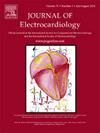Left ventricular systolic dysfunction screening in muscular dystrophies using deep learning-based electrocardiogram interpretation
IF 1.3
4区 医学
Q3 CARDIAC & CARDIOVASCULAR SYSTEMS
引用次数: 0
Abstract
Background
Routine echocardiographic monitoring is recommended in muscular dystrophy patients to detect left ventricular systolic dysfunction (LVSD) but is often challenging due to physical limitations. This study evaluates whether artificial intelligence-based electrocardiogram interpretation (AI-ECG) can detect and predict LVSD in muscular dystrophy patients.
Methods
Patients aged >16 years who underwent an ECG and echocardiogram within 90 days at the University Medical Center Utrecht were included. Patients with Duchenne (DMD), Becker (BMD), limb-girdle muscular dystrophy (LGMD). myotonic dystrophy (MD), and female DMD/BMD carriers, were identified. A convolutional neural network (CNN) was trained on a derivation cohort of patients without muscular dystrophy to detect LVSD and tested on muscular dystrophy patients. A Cox proportional hazards model assessed AI-ECG's predictive value for new-onset LVSD.
Results
The derivation cohort included 53,874 ECG-echocardiogram pairs from 30,978 patients, while the muscular dystrophy test set comprised 390 ECG-echo pairs from 390 patients. LVSD prevalence varied from 81.3 % in DMD to 13.4 % in MD. The model achieved an AUROC of 0.83 (0.79–0.87) in the muscular dystrophy test set, with sensitivity 0.87 (0.81–0.93), specificity 0.58 (0.52–0.63), NPV 0.91 (0.86–0.95), and PPV 0.49 (0.43–0.56). AI-ECG predicted new-onset LVSD with an AUROC of 0.72 (0.66–0.78), with AI-ECG probability being a significant predictor.
Conclusions
AI-ECG can detect LVSD in muscular dystrophy patients, offering a non-invasive, accessible tool for risk stratification and an alternative to routine echocardiography. It may also predict new-onset LVSD, enabling earlier intervention. Further research should explore external validation, pediatric application, and integration within the clinical care plan.

利用基于深度学习的心电图解释筛选肌营养不良患者的左心室收缩功能障碍
背景:在肌萎缩症患者中,推荐常规超声心动图监测以检测左心室收缩功能障碍(LVSD),但由于身体限制,通常具有挑战性。本研究评估基于人工智能的心电图解释(AI-ECG)是否可以检测和预测肌营养不良患者的LVSD。方法选取年龄16岁、90天内在乌得勒支大学医学中心接受心电图和超声心动图检查的患者。Duchenne (DMD)、Becker (BMD)、肢带性肌营养不良(LGMD)患者。肌强直性营养不良(MD)和女性DMD/BMD携带者。卷积神经网络(CNN)在非肌营养不良患者衍生队列上进行训练以检测LVSD,并在肌营养不良患者中进行测试。Cox比例风险模型评估AI-ECG对新发LVSD的预测价值。结果衍生队列包括来自30,978例患者的53,874对心电图,而肌肉萎缩症测试组包括来自390例患者的390对心电图。DMD组LVSD患病率为81.3%,MD组为13.4%。该模型在肌萎缩症组的AUROC为0.83(0.79-0.87),灵敏度为0.87(0.81-0.93),特异性为0.58 (0.52-0.63),NPV为0.91 (0.86-0.95),PPV为0.49(0.43-0.56)。AI-ECG预测新发LVSD的AUROC为0.72(0.66-0.78),其中AI-ECG概率是一个显著的预测因子。结论sai - ecg可检测肌营养不良患者的LVSD,是一种无创、易获取的危险分层工具,可替代常规超声心动图。它也可以预测新发LVSD,使早期干预成为可能。进一步的研究应探索外部验证,儿科应用,并纳入临床护理计划。
本文章由计算机程序翻译,如有差异,请以英文原文为准。
求助全文
约1分钟内获得全文
求助全文
来源期刊

Journal of electrocardiology
医学-心血管系统
CiteScore
2.70
自引率
7.70%
发文量
152
审稿时长
38 days
期刊介绍:
The Journal of Electrocardiology is devoted exclusively to clinical and experimental studies of the electrical activities of the heart. It seeks to contribute significantly to the accuracy of diagnosis and prognosis and the effective treatment, prevention, or delay of heart disease. Editorial contents include electrocardiography, vectorcardiography, arrhythmias, membrane action potential, cardiac pacing, monitoring defibrillation, instrumentation, drug effects, and computer applications.
 求助内容:
求助内容: 应助结果提醒方式:
应助结果提醒方式:


